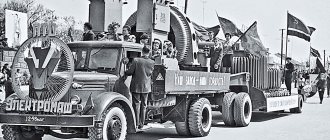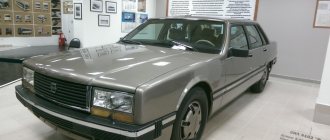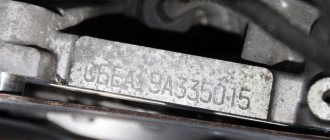Among the dozens of models and hundreds of modifications of the famous Moscow plant, there were also those that were little known in the days of their youth. Among such vehicles there were cars, buses, and trucks.
In 1938, young engineers Vladimir Kremenetsky, Nikolai Pulmanov and Anatoly Pukhalin, who were bored with the factory routine, decided to build a sports car unprecedented in the USSR based on the executive ZIS-101. The artist (the term designer did not yet exist) Valentin Rostkov was brought in to create a car with an advanced look for 1938 in the “chic-modern” style.
The creators themselves said that the 1938 ZIS-Sport is a “chic-modern” class car.
The car was sculpted in the evenings after work. Engineers increased the volume and power of the production engine, bringing the latter to 141 hp. (the most powerful production version of the ZIS-101 developed 116 hp), anti-roll bars were used in the suspension. The director of the plant, I. A. Likhachev, learned about the sports car, who accepted the idea and even included the car in the list of gifts from the plant to the Motherland for the 20th anniversary of the Komsomol.
From that moment on, the construction of the machine became a factory-wide affair. According to calculations, the ZIS-Sport was supposed to reach 180 km/h - a huge speed for the USSR in those years. During tests on the Minsk highway, V. Petrov accelerated, however, only to 162.4 km/h. But this result for Soviet cars of the 1930s was impressive. Likhachev ensured that the green sports ZIS was displayed in the foyer of the House of Unions at the XVII Party Conference, for which purpose the street wall was dismantled and reassembled in one night . Alas, it was unthinkable to imagine such a car in the USSR, even in a small series. The only example of “chic modern” was apparently lost during the evacuation of the plant in the terrible autumn of 1941.
Initiative from below
If the history of the ZIS-101 had begun with a more “correct” statement of the task, the fate of the first domestic luxury car could have been much more successful. Assembling one copy of a “replica” of an extremely complex, “sophisticated” foreign analogue from hand-made parts is a simple matter.
But when the question arose about the mass production of such cars, the customer, represented by the state, should have taken a more balanced, pragmatic position, focused not on sovereign ambitions, but on the real production capabilities and qualifications of mechanics servicing state-owned garages.
The design of a high-class limousine was inherited by the Stalin Plant (ZIS) from colleagues from the Leningrad “Red Putilovets”. Leningraders tried to accurately reproduce the American car Buick-32-90 of the 1932 model year and prepare it for mass production as a “six-window sedan”. Who came up with the idea in the early thirties to propose a project that was obviously unaffordable? It turned out that it was a “bottom-up initiative.”
It all started in 1932, when it was decided to stop production of obsolete Fordson tractors at Krasny Putilovets. A group of plant specialists, led by technical director M.L. Ter-Asaturov, took the initiative to use the freed production capacity to produce passenger cars.
Along the administrative-party chain, this initiative reached the People's Commissariat of Heavy Industry, which at that time oversaw the automotive industry, and, having turned into a directive there, returned to the plant in the form of an order signed by the manager of the All-Union Automotive and Tractor Association (VATO) S. S. Dyakonov. According to this order, the plant had to create and prepare for production a luxury car.
At that moment, it was only about the type of car, and Leningraders had the opportunity to choose a completely “lifting” prototype. The customer was not the Special Purpose Garage (GON), which served the top officials of the state, but the industry ministry - which means that the main task was not to provide the state elite with an executive limousine, but rather an ideological victory: it was necessary to prove to the whole world that we can produce high-class passenger cars . It is not for nothing that the work was subsequently carried out under the slogan “Give us a Soviet Buick!”
Creating our own original design by the engineers of the tractor plant was out of the question: initially it was planned to simply reproduce a foreign car of the corresponding class. The “fatal mistake” was made at the prototype selection stage.
It is difficult to say whether the Buick-32-90 was chosen by chance (presumably, this particular model was the official car of either M.L. Ter-Asaturov or S.M. Kirov) or one of the high-ranking officials decided to “take a swing at to the maximum,” but it would be difficult to find a more unsuitable object for development.
The fact is that this Buick model at that time was super-progressive even by American standards. Suffice it to mention the in-line eight-cylinder overhead valve engine with a lower camshaft and roller tappets on the rods; complex dual carburetors equipped with heating of the fuel mixture and automatic adjustment of the air damper; a cooling system equipped with a thermostat and a radiator shutter control mechanism; lever hydraulic shock absorbers with remote adjustment of their resistance; a centralized lubrication system for chassis components and a unique semi-automatic clutch control mechanism.
Be that as it may, “Krasny Putilovets” took on obligations - “he called himself a milk mushroom.” Now all that was left was to “get into the back.” Already in January 1933, the magazine “Behind the Wheel” wrote about the plant’s plans to master the production of a copy of the Buick and about the readiness of Leningraders to subsequently produce up to 20 thousand cars a year. Nobody dared to ask why the country needs so many executive class limousines.
And then what was supposed to happen happened. By the predetermined date - May 1, 1933 - at the plant, at the cost of incredible efforts, virtually by hand, six experimental cars were manufactured and assembled, simply named “L-1” (“First Passenger”). The cars marched through the streets of Leningrad as part of the May Day demonstration, then drove to Moscow, where they were presented to Sergo Ordzhonikidze, who headed the People's Commissariat of Heavy Industry. Ordzhonikidze approved of luxury cars.
Today it is no longer important whether all six L-1s really “broke down and fell apart” on the way back to Leningrad or whether this is just a myth. Fortunately for Krasny Putilovets, in 1933 the industry People's Commissariat reoriented the enterprise to the production of three-turreted T-28 tanks, and later Universal row crop tractors. There was nowhere and no one to bring limousines to mass production - all the forces and capacities were thrown into solving priority strategic tasks, and the still crude Buick project was transferred to the Stalin Plant for further development.
"Mule" truck and limousine
By the way, the passenger car workshop gave birth to another unusual design. Low cars on passenger wheels with a clearly wide cabin for them were sometimes found on the streets, arousing the curiosity and surprise of passers-by. The cars were called ZIL-113G, but they were never commercially available, but were a passenger chassis with a passenger engine, but with a truck cab and an onboard platform with an awning. The first such car was built back in 1959 with a ZIL-157 cab; later the ZIL-131 cab was used. Firstly, these cars served as carriers of passenger limousine units without an expensive body. Secondly, they were used as “housewives” - cars carrying belongings necessary for long runs and business trips. On the highway, such a truck was capable of reaching speeds of up to 170 km/h , which means it practically kept up with the experimental “member trucks.” It is interesting that already in the 1990s such a car was seriously considered as an object for mass production...
ZIL-113G - a handicraft truck of factory testers
But first, let’s remember the luxury minibus “Yunost”, which was produced under the designations ZIL-118, ZIL-119 and ZIL-3207 from 1961 to 1994. Among the later modifications, one of the most interesting is the ZIL-E118KV ambulance with a high roof. A couple of these cars (one from 1978, the other from 1984) worked at the City Ambulance Station in Moscow, and also appeared in several films.
The first version of the sanitary ZIL-E118KV, 1978.
And in the early 1990s, when choosing the design of a light-duty truck based on a luxury minibus, they made a ZIL-3302 pickup and laid down a one-ton flatbed truck with a Perkins engine. This sample was never completed. So, the ZIL-113G was also considered as an alternative to such a pickup truck. For mass production, however, they chose a more practical, load-lifting and cheaper option with the ZIL-4331 cab, in the production of which huge amounts of money had already been invested. This is how the ZIL-5301 “Bull” turned out.
Prototype ZIL-3302
This model was offered in many modifications in the 1990s, the vast majority of which were, in fact, only prototypes. In 1996, in the small series workshop under the leadership of Yu. Tumanov, the ZIL-5302YUG was created. The vehicle with a 6x2 wheel arrangement had a third lifting axle. On the basis of this prototype, they made a simpler ZIL-5302AL with a rolling axle. A model with a carrying capacity of 6100 kg has been produced since 1999 as a tow truck , but in very small quantities.
ZIL-5302 “Bull” with 6×2 wheel arrangement
A little earlier they made another unusual “Bull” - ZIL-3313GO. It was a separate sanitary module on a truck chassis. Five to seven doctors could travel with three bedridden patients. The car, created jointly by ZiL and OJSC NPO Ekran, was planned to be equipped with MMZ and Caterpiller engines.
Experienced reanimobile ZIL-3313GO
But neither this “ambulance” nor other attempts to change the fate of the plant helped...
mission Impossible
It’s scary to imagine what would have happened at Krasny Putilovets if he had not received an order for tanks and tractors in time. The domestic industry of that time was not ready for mass production of such complex and capricious equipment as the “Russified” Buick-32-90. However, no one dared to declare that “mission impossible”, and as a result, the ZIS designers were tasked not only with developing a top-class passenger car, relying on the experience of their predecessors (including negative ones), but with bringing to mind ( and before production) platform L-1.
Fortunately, there was no talk of an exact copy of the Buick, which gave the Muscovite engineers some freedom, but the general architecture of the L-1 had to be preserved. The work on redesigning the prototype was headed by the chief designer of the plant, E. I. Vazhinsky. In 1934, the Buick itself was delivered to the ZIS for study, albeit of a different model, newer and simpler: it was the limousine of the current year - model “57” of the “90” series.
During adaptation to production, the engine of the future production car retained all its design features and options, including a crankshaft with counterweights and a torsional vibration damper, a complex gas distribution system, a two-chamber Marvell-type carburetor with heating of the working mixture and a thermostat in the cooling system. The chassis and chassis were significantly simplified, focusing specifically on the design of the new Buick.
Fortunately for our engineers, the Americans abandoned complex and unreliable transmission and suspension systems, so the designers seized the opportunity, without violating the technical specifications, to equip the car with non-adjustable shock absorbers and an ordinary double-disc clutch. Among the innovations, it is worth noting the vacuum booster of the mechanical brake drive.
Already in October 1934, E. I. Vazhinsky described in detail in the magazine “Behind the Wheel” the design of the future ZIS-101 car, stating at the very beginning of the article that the new car was designed like the best American brands Buick and Packard. The material was illustrated with photographs of the exterior and interior of the Buick. Interestingly, the model was not a limousine located at the factory, but a four-window sedan. Next to this photo there was a caption: “General view of the new ZIS-101 model.”
Automotive fashion in those years was changing rapidly, and the artists of the ZIS body department, headed by I.F. German, understood perfectly well that by the time production of the new car began, not only the “suitcase-like” body of the L-1 would be outdated, but also the rounded body of the later Buick ", taken as a sample. Therefore, the bodybuilders insisted on making the body according to the original sketches.
Unlike their Leningrad colleagues, who intended to produce equipment for the production of bodies on their own or with the help of subcontractors, Moscow body makers from the very beginning focused on the manufacture and purchase of dies abroad. And since the equipment had to be ordered in any case, it means that we could afford to develop a more modern variation on the theme of the American prototype.
This is what happened later. The body design based on the finished original layout was carried out by the Philadelphia company Budd Manufacturing. They purchased machines for stamping the chassis and body from her - for 1.5 million dollars. For another half a million, they purchased sheet metal presses from the Hamilton Foundry and Machine Company from Ohio.
The mistake of the ZIS customers was that they entrusted the design of the body to a company that had experience in creating similar structures only for luxury cars. Such machines were traditionally produced abroad in small batches, and therefore the assembly was not supposed to be a conveyor belt, but a slipway, with a large share of manual labor and individual adjustment of the elements of each copy. For a structure consisting of a load-bearing wooden frame and sheet panels “fitting” it, this assembly technology was quite acceptable. But the Stalin Plant was focused on assembly line production!
In 1935, ZIS received equipment and 500 sets of finished stampings from the USA, and on December 16 of the same year, the country’s top leadership approved the “Production Program for the Production of the ZIS-101 Passenger Car.”
By the end of April 1936, the first pre-production samples were built, and on April 29, two of them were demonstrated in the Kremlin. Stalin was present at the viewing. By the way, it was the demonstration of the ZIS-101 that marked the beginning of a tradition - an unspoken but mandatory procedure for the “presentation” of pre-production samples of domestic vehicles to the top officials of the state. Subsequently, the fate of our cars for decades depended on the favor of the leaders. One way or another, Stalin liked the ZIS-101, and the task could be considered completed.
Characteristics of the ZIS-5 truck
A country:USSRType:Truck (4 x 2)Date of issue:1933Length:6060 mmWidth:2235 mmHeight:2160 mmArmor, forehead:NoArmor, side:NoArmor, tower:NoCrew:1 person (cabin seats: 2)Engine:73 hp at 2300 rpm Travel range:205 kmMaximum speed:60 km/h on the highwayWeight:3000 kg + 3000 kg cargoWeapons:No
Test of endurance
For the pre-production batch of five cars, the test of strength was a motor rally along the route Moscow-Leningrad-Kyiv-Moscow. On June 11, 1936, all the cars returned to Moscow in full working order, having won a dispute in absentia with L-1 about the advisability of blindly copying ready-made Western models.
However, it was too early to celebrate. The first limousines were assembled using slipway technology in the empty basement of one of the factory workshops. In total, in 1936, they managed to assemble 11 cars on their own. After the new press building was put into operation, an assembly line was set up in its sixth and seventh spans, from which the first production ZIS-101 rolled off on January 18, 1937.
With the start of mass production (up to 17 cars per day) of a new domestic high-class passenger car, problems began. Firstly, conveyor technology did not allow us to devote enough time and attention to fitting the elements of the beech body frame.
As a result, the bodies of some cars began to squeak unpleasantly when driving already from the moment of production, others - during operation, after minor distortions of the frame chassis and drying out of the frame itself. Secondly, it soon became clear that the plant was not technologically ready to produce such a complex machine.
An attempt to operate the ZIS-101 in the Special Purpose Garage ended in failure. The GON management considered the technical characteristics of the domestic limousine “insufficient”: simply put, the car was inferior in key indicators to the foreign cars that formed the basis of the Kremlin vehicle fleet in those years.
The cars were transferred to the passenger garage of the NKVD operational department - to accompany the cars of the top officials of the state, but even here the ZISs did not take root. No one made a tragedy out of this, because the “ideological super task” was completed - “We did it!” In 1937, the ZIS-101 (along with the GAZ-M1) represented the country at the World Exhibition in Paris.
However, such an expensive product had to find practical application. And the limousines rejected by the GON poured into government garages of a lower rank - vehicle fleets of the People's Commissariats, embassies, regional party committees. The excess of ZIS passenger cars made it possible to use them even as taxis and ambulances. Thus, thousands of professionals - drivers and mechanics - were able to evaluate the real performance and quality of production and assembly of these cars.
In 1937, in the October issue (No. 20) of the magazine “Behind the Wheel,” an open letter from three employees of the Narkomtyazhprom motor depot was published, entitled “Several questions to the automobile plant named after. Stalin." In fact, the letter did not contain any questions. It listed “inherent defects” in the design, defects in assembly and components that caused constant breakdowns. At that moment, this car depot had 14 ZIS-101 vehicles at its disposal, so these were typical cases.
Serious complaints were caused by defects in the crank mechanism (the engine knocked), constantly breaking valve springs, unreliable power and electrical systems, plastic linings on the brake pads, poor quality of control devices and window seals, and even a sound signal that quickly drained the battery.
The “red thread” in the letter was the topic of fuel consumption. People complained that the appetites of the ZIS-101 with a “native” carburetor required 28-31 liters of gasoline per 100 km, while the similar Lincoln class consumed 22.5 liters, and the ZIS itself with a Buick carburetor consumed significantly less fuel.
From that moment on, a dark streak began for the creators and manufacturers of the first domestic serial limousine. The leading designer of the ZIS-101, Evgeny Vazhinsky, was removed from the post of chief designer of the plant in 1937 and appointed head of the chassis department. In March 1938, Vazhinsky was arrested and shot as an enemy of the people, although this had nothing to do with the shortcomings of the ZIS. Moreover, on February 5, 1939, the “red director” of the Stalin Plant, Ivan Alekseevich Likhachev, was appointed head of the People’s Commissariat of Medium Engineering of the USSR.
Despite all the efforts of factory workers and subcontractors, the design and quality of the ZIS-101 left much to be desired. In June 1940, a special government commission was created to study the defects of the limousine under the leadership of an automobile expert, member of the USSR Academy of Sciences Evgeniy Chudakov. Based on the results of the work of this commission, a resolution was issued by the Council of People's Commissars of the USSR and the Central Committee of the All-Union Communist Party of Bolsheviks, which raised the problem of the quality of the ZIS-101 to the state level.
Here is an excerpt from this resolution:
“Note the presence of a large number of defects in ZIS-101 passenger cars produced by the plant named after. Stalin Narkomsredmash, in particular: a strong smell of gasoline in the body, gearbox noise, engine knocking and increased gasoline consumption, frequent breakdown of springs and stiffness of the suspension, rapid failure of electric clocks, fuel indicators, windshield wipers, etc.
The presence of these defects is the result of a careless attitude towards the quality of manufactured machines on the part of the former director of the plant named after. Stalin, now the People's Commissar for Medium Machine Building Comrade Likhachev, and the current director of the plant named after. Stalin, Comrade Volkov, especially recently.
Narkomsredmash Comrade Likhachev both as a people's commissar and as a former director of the plant named after. Stalin allowed the production of substandard cars from the plant, did not take measures to eliminate the defects and hid the presence of these defects from the government...”
This is how the careless choice of the Buick-32-90 as a prototype for creating the first Soviet limousine at Krasny Putilovets came back to haunt the factory workers.
Son of difficult mistakes
It was almost impossible to eliminate the design flaws of the ZIS-101 in a short time. But the designers themselves knew very well the weaknesses of their brainchild, so the “package of changes” began to take shape long before the ominous decree was issued - almost immediately after the start of production of the “one hundred and first”.
In particular, to increase engine power, a new Stromberg-type carburetor with falling flow was used, changes were made to the design of the intake manifold, and valve timing was optimized. Contrary to popular belief, aluminum pistons were installed extremely rarely on cars of the 101st family. The estimated engine power is 116 hp. With. in practice it was not possible to achieve this.
In the second half of 1940, production began of a modernized modification of the executive limousine - ZIS-101A. The car was equipped with a more powerful engine (100-110 hp) and an improved transmission. The frame remained wooden. Externally, the ZIS-101A differed from its predecessor with a new, more modern radiator lining and hood.
The “corrected” limousine got rid of most of the minor shortcomings, but retained the main one - the excess (in relation to power) mass of all structural elements. And yet, with some stretch, it could be considered “the pride of the domestic automobile industry.” Changes for the better were also noticed in the Special Purpose Garage: ZIS-101A were used in GON, albeit in a secondary role, but much more actively than the ZIS-101.
Garages, which were supposed to have top-class cars according to their rank, were quickly filled with the same type of ZIS-101, and later ZIS-101A limousines. At the same time, government garages tried to get rid of them as soon as possible, and already a couple of years after the start of mass production, the question of reducing production volumes was burning. Since 1940, the production of such machines has decreased almost tenfold.
Limousines unsuitable for milking service were not mobilized to the front and, for the most part, remained in the rear. In the post-war period, outdated cars began to be rebuilt for the needs of the national economy. Based on the ZIS-101 and ZIS-101A, many interesting, initially “unplanned” modifications were born.
ZiS-102A. 1939
0
Source:
The very idea of a removable awning was an engineering novelty for the USSR. The roof was made of a metal frame with wooden posts, covered with a rubberized awning. Padded quilts were sewn into the waterproof material to round the sections. At the rear of the tent there was a window with a chrome frame. The doors had removable, soft side panels with celluloid. When the awning was removed, these side panels were hidden in a special case in the trunk of the car. Due to the “loss” of the roof, the body lost the necessary rigidity. The body had to be further strengthened; a special rear belt with a metal wall was used.











